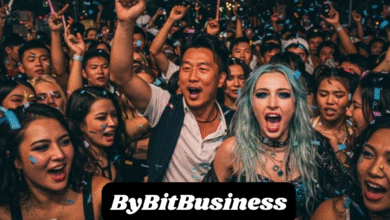The Phenomenon of InfluencersGoneWild: Unveiling the Wild Side of Social Media Influence

InfluencersGoneWild Social media influencers have become a dominant force in today’s digital age. From Instagram to YouTube, TikTok, and even Facebook, these individuals hold significant sway over public opinions, consumer behavior, and trends. However, in recent years, there has been a new phenomenon emerging within this space: “InfluencersGoneWild.” This term captures the chaos, unpredictability, and occasionally reckless behaviors displayed by influencers, often as a result of their quest for greater attention, engagement, or virality.
In this article, we will explore the origins of the “InfluencersGoneWild” trend, the motivations behind it, and its impact on both the influencers themselves and their followers. We will also delve into the ethical dilemmas, controversies, and consequences associated with this rising trend.
The Rise of the Influencer Culture
To understand the phenomenon of “InfluencersGoneWild,” it is essential first to grasp how influencer culture came to be. In the early days of social media, platforms like MySpace and Facebook allowed individuals to share updates and photos, but the concept of being an influencer wasn’t as established. However, with the advent of Instagram and YouTube, the idea of monetizing one’s social presence began to take root. Influencers could post sponsored content, collaborate with brands, and generate revenue from their follower count.
Over time, influencers became synonymous with aspirational lifestyles, beauty standards, travel destinations, and luxury goods. They built loyal communities of followers who sought their advice, recommendations, and inspiration. Some influencers even expanded into other areas like fashion, fitness, tech, and entrepreneurship.
However, as the competition to maintain relevance grew, many influencers began to feel the pressure to constantly create more engaging, eye-catching, and often sensational content. This pressure led to the birth of the “InfluencersGoneWild” phenomenon.
What Does “InfluencersGoneWild” Really Mean?
The term “InfluencersGoneWild” refers to moments where influencers behave in an unpredictable or shocking manner to garner attention or increase engagement. These actions might range from posting controversial or extreme content to breaking social media norms or even engaging in behavior that could harm their personal reputation or their brand partnerships.
The driving force behind this behavior is the relentless pursuit of virality. Influencers live in an era where engagement metrics—likes, comments, shares, views—are their currency. The more attention they generate, the more brands are willing to pay for sponsored collaborations. Consequently, this leads many influencers to push boundaries in ways that may not always align with their authentic selves or ethical considerations.
While some of these stunts may be planned or staged for entertainment purposes, others can cross into areas of recklessness or irresponsibility. From outrageous challenges to boundary-pushing fashion choices and even controversial political statements, the quest for attention has sometimes resulted in influencers going “wild” to the point of alienating their audiences.
The Motivations Behind InfluencersGoneWild
The Desire for Virality and Fame
At the core of this behavior lies the desire to go viral. The fame and wealth that accompany a viral post can significantly elevate an influencer’s career. This is particularly enticing in a landscape where influencer marketing is an industry worth billions of dollars. Influencers know that viral content can exponentially increase their visibility, attract lucrative brand deals, and help them maintain relevance in a rapidly changing digital environment.
Pressure to Stay Relevant
As social media platforms continue to evolve, the algorithms that dictate what content gets seen are becoming increasingly sophisticated. To remain visible, influencers must constantly churn out new content. This pressure to stay relevant can lead influencers to take drastic measures, whether it’s engaging in controversy, showing off increasingly eccentric lifestyles, or posting more audacious content to catch people’s attention.
The Search for Authenticity
Ironically, some influencers “go wild” as part of an effort to seem more authentic to their followers. As audiences become more aware of the highly curated nature of influencer content, they crave a sense of realness. In some cases, influencers may resort to outlandish behavior or behind-the-scenes glimpses into their lives to connect more intimately with their followers. Unfortunately, in the pursuit of authenticity, some influencers may cross lines or end up creating an exaggerated or even harmful image of themselves.
Escaping the “Insta Perfection” Trap
Social media often presents a flawless version of reality, with influencers showcasing picture-perfect lives, bodies, and vacations. For some, the desire to escape this idealized image leads them to embrace more unfiltered and wild expressions of themselves. While some followers appreciate this departure from perfection, others may feel uncomfortable with the extreme nature of the behavior.
The Impact of InfluencersGoneWild on Followers
The Positive Impact: Inspiration and Empowerment
In some cases, influencers going wild can have positive effects. By challenging societal norms and expectations, they may inspire others to embrace their individuality or take risks in their own lives. For example, influencers who embrace body positivity, unconventional fashion, or radical self-expression may empower their followers to do the same. In this way, “InfluencersGoneWild” can lead to a shift in cultural attitudes toward self-confidence and acceptance.
The Negative Impact: Ethical Concerns and Harmful Trends
However, there is a darker side to the “InfluencersGoneWild” phenomenon. The most significant concern is the potential harm that these influencers might inflict on their audiences. Young followers who look up to these influencers may feel compelled to imitate their wild behavior, even if it’s reckless or dangerous.
Additionally, many of these wild stunts involve sensationalizing harmful trends, such as extreme dieting, dangerous beauty procedures, or risky physical challenges. These types of behavior can perpetuate unhealthy standards of beauty, self-worth, and risk-taking, often with little regard for the long-term consequences on followers’ mental and physical health.
The ethical concerns surrounding this phenomenon also extend to influencers who may engage in problematic or exploitative content. For example, promoting unrealistic beauty standards, spreading misinformation, or encouraging unsafe behaviors can be harmful not only to followers but also to the broader social media ecosystem. In some instances, influencers might be involved in scams or questionable business practices that put their followers at risk.
The Legal and Brand Implications of InfluencersGoneWild
While “InfluencersGoneWild” might seem like a form of rebellion or creative freedom, there are significant legal and brand-related implications. Brands that collaborate with influencers are often highly selective, choosing individuals whose personal values align with their own. A wild or controversial influencer behavior can put these partnerships at risk, leading to brand boycotts, loss of sponsorships, or public backlash.
Moreover, influencers must be aware of the legal ramifications of their actions. In some cases, stunts or wild behavior may violate platform guidelines or even the law, such as promoting illegal activities, engaging in hate speech, or posting content that violates copyright or intellectual property rights. As social media platforms become more regulated, influencers may face consequences for pushing boundaries that go against community guidelines or legal frameworks.
Conclusion: The Future of InfluencersGoneWild
The rise of “InfluencersGoneWild” is a byproduct of an ever-changing digital landscape that rewards attention-grabbing behavior. As influencer culture continues to evolve, it is likely that we will see even more extreme content and attention-seeking stunts. However, it remains to be seen how this trend will evolve in the face of increasing scrutiny from audiences, brands, and social media platforms.
As audiences become more discerning and aware of the consequences of influencer behavior, there may be a shift toward a more responsible form of influence—one that values authenticity, ethics, and long-term relationships over temporary viral success. Influencers, too, may begin to recalibrate their approach, realizing that their impact on society is more significant than a single viral post.
Frequently Asked Questions (FAQs)
1. What is “InfluencersGoneWild”?
“InfluencersGoneWild” refers to moments when social media influencers engage in unpredictable, outrageous, or controversial behaviors to gain attention, go viral, or boost engagement. These actions often push the boundaries of typical influencer content and can sometimes lead to reputational damage or backlash.
2. Why do influencers go wild?
The motivations behind influencers going wild include the desire for virality, the pressure to stay relevant in a crowded space, the pursuit of authenticity, and the desire to break free from the “Instagram perfection” trap. In many cases, influencers may engage in these behaviors as a way to stand out and attract more followers or brand deals.
3. How does “InfluencersGoneWild” affect followers?
While some followers might find the wild behavior empowering or entertaining, others may be influenced to imitate risky or harmful behaviors. Additionally, some content can perpetuate unrealistic beauty standards or dangerous trends, leading to negative impacts on followers’ mental and physical health.
4. Are there legal implications for influencers who go wild?
Yes, influencers can face legal and brand-related consequences InfluencersGoneWild for their actions. If an influencer engages in behavior that violates platform guidelines, promotes illegal activities, or harms their reputation, they could face penalties, lose sponsorship deals, or even face lawsuits.
5. Is “InfluencersGoneWild” a trend that will last?
It is uncertain whether this trend will continue in the long run. As social media evolves and audiences become more aware of the ethical considerations surrounding influencer behavior, there may be a shift toward more responsible and authentic forms of influence. However, the desire for attention and virality is likely to remain a driving force for many influencers.



